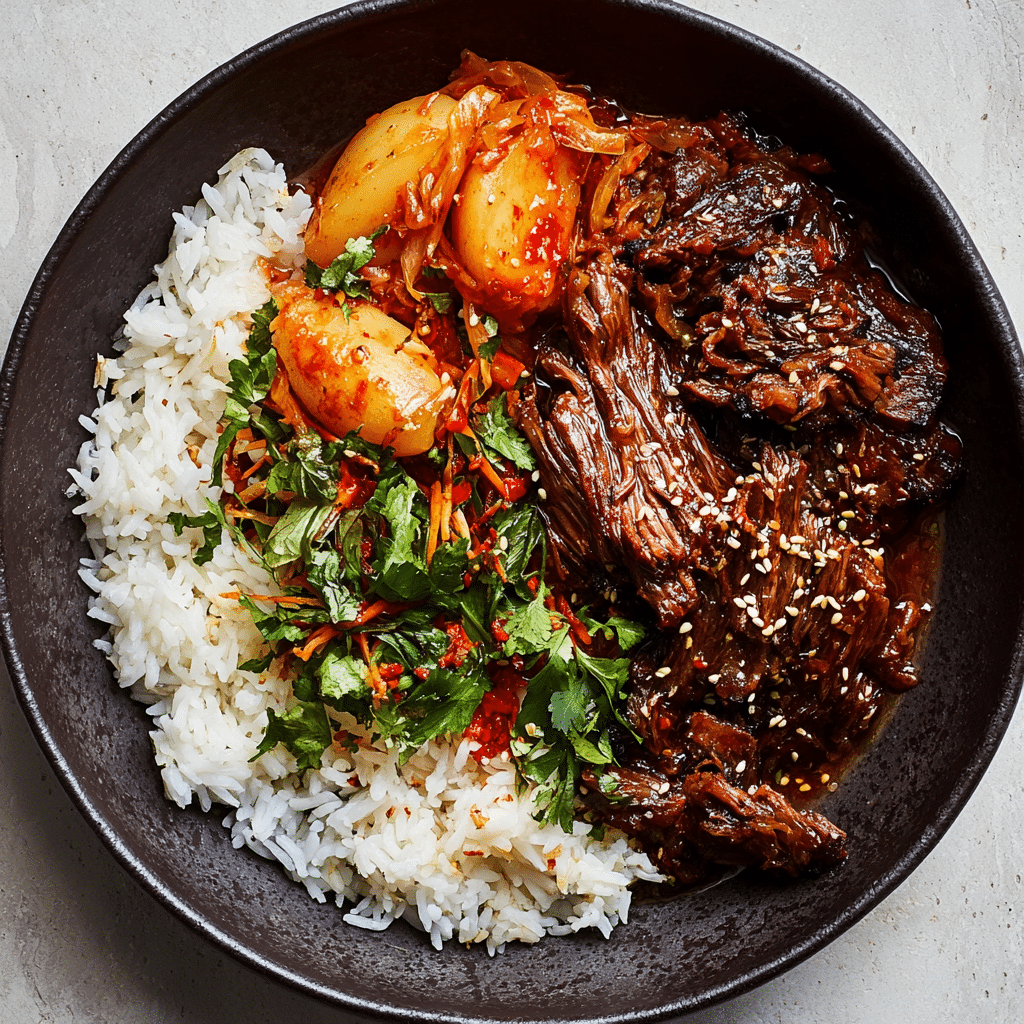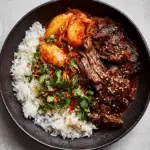This Korean‑Style Pot Roast takes the classic comfort of slow‑braised beef and elevates it with the bold sweetness and heat of gochujang sauce. Tender chunks of chuck roast soak up an irresistible blend of savory soy, warming ginger, and umami‑rich chili paste, transforming every forkful into a tribute to Korean fusion cooking.
Perfect for cozy dinners or weekend meal prep, this one‑pot wonder delivers deep flavor with minimal fuss. The fragrant, rich sauce thickens into a glossy glaze, coating juicy beef and tender veggies—a dish that brings warmth, spice, and smiles to any table.
Full Recipe
Ingredients:
-
-
3 lb (1.4 kg) beef chuck roast
-
1 large onion, sliced
-
4 cloves garlic, minced
-
2 ” piece fresh ginger, thinly sliced
-
1/2 cup low‑sodium soy sauce
-
1/3 cup gochujang (Korean chili paste)
-
1/4 cup brown sugar
-
2 tbsp rice vinegar
-
2 tbsp sesame oil
-
1 cup beef broth
-
2 carrots, cut into 2″ pieces
-
2 celery stalks, cut into 2″ pieces
-
1 tbsp cornstarch mixed with 1 tbsp water (slurry)
-
2 green onions, sliced (for garnish)
-
Toasted sesame seeds (for garnish)
-
Directions:
-
-
Preheat oven to 325 °F (160 °C).
-
Season the roast with salt and pepper. In a Dutch oven over medium-high heat, brown all sides in sesame oil (~3 min per side). Remove and set aside.
-
Sauté onion, garlic, ginger in the pot until fragrant (~3 min).
-
Stir in soy sauce, gochujang, brown sugar, rice vinegar and beef broth until combined.
-
Return the roast to the pot, cover, and braise in oven for 3 hours, adding carrots and celery after 2 hours.
-
Remove roast and veggies; tent with foil to rest.
-
Skim fat, bring sauce to simmer on stovetop, whisk in cornstarch slurry until thickened (~2 min).
-
Slice roast, arrange with vegetables, drizzle with sauce and garnish with green onions & sesame seeds.
-
Prep Time: 15 minutes | Cooking Time: 3 hours 15 minutes | Total Time: 3 hours 30 minutes
Kcal: approx. 550 kcal per serving | Servings: 6 servings
Introduction to Korean-Style Pot Roast
Korean-Style Pot Roast is a delightful fusion of classic Western slow-cooking techniques with bold, distinctly Korean flavors. Instead of the traditional mirepoix, potatoes, and gravy, this dish boasts a spicy-sweet gochujang sauce, soy-based umami depth, and a gentle kick of ginger and garlic. It’s the perfect example of global culinary harmony—where comfort food traditions meet bold seasoning and spice. This dish is especially popular for its ability to serve as both a show-stopping dinner-party centerpiece and a cozy family meal.
This dish isn’t just delicious—it tells a story. It draws on the nostalgic comfort of pot roast, which many cultures around the world embrace in one form or another, and adds the intensity of Korean flavors that are rising in global popularity. The end result is a roast that’s juicy, fork-tender, and dripping with an intensely flavorful glaze you’ll want to spoon over everything from rice to roasted vegetables.
The Influence of Korean Cuisine
Korean cuisine is known for its strong focus on fermentation, spice, and depth of flavor. Dishes like kimchi, bulgogi, and jjigae have become increasingly popular worldwide, and ingredients like gochujang—fermented Korean red chili paste—have earned a place in many modern kitchens. Gochujang is central to this pot roast recipe. It’s slightly sweet, a bit spicy, and intensely umami-rich, which allows it to double as a marinade and a simmering sauce.
This dish is a great introduction for anyone new to Korean cooking because it uses familiar ingredients—beef, soy sauce, garlic—alongside more unique ones like gochujang and sesame oil. These elements come together to create a rich, sticky glaze that clings to the meat in the most appetizing way. While it’s unmistakably Korean in flavor, it doesn’t stray too far from familiar territory, making it accessible to most palates.
Why Chuck Roast Works Best
Chuck roast is ideal for braising. Its marbling and connective tissue break down beautifully during long, slow cooking, resulting in succulent, pull-apart meat. When braised in a sauce as flavor-packed as this one, it acts like a sponge, absorbing every nuance of flavor while remaining incredibly tender. The slow cooking not only enhances the texture of the meat but also allows time for the sauce to reduce and develop complexity.
In Korean cooking, beef is often reserved for special occasions, and it’s typically prepared in ways that maximize flavor. That tradition is honored in this dish. Though chuck is considered a more economical cut, its transformation into something luxurious and deeply satisfying through braising is what makes this dish feel both rustic and gourmet.
Flavor Profile Breakdown
What makes this recipe truly memorable is its balance of flavors. The soy sauce adds a salty backbone and umami richness. The gochujang brings a gentle but lingering heat and subtle sweetness. Garlic and ginger infuse the roast with aromatic brightness, while brown sugar and rice vinegar add a subtle sweetness and tang to round out the sauce. The sesame oil adds a nutty aroma that is signature to many Korean dishes.
Each element complements the others without overwhelming the dish. This balance is crucial in Korean cuisine, where the ideal meal includes contrasting but harmonious tastes—spicy, savory, sour, and sweet. The sauce thickens into a glossy glaze that coats each bite, making it an indulgent experience from the first forkful to the last.
Pairing Suggestions
This Korean-Style Pot Roast is rich and bold, so pairing it with lighter, contrasting sides works best. Steamed white rice is a classic choice—it absorbs the savory sauce perfectly. You can also serve it with quick-pickled vegetables for a sharp, crunchy contrast that cuts through the richness of the beef.
Kimchi is another fantastic companion. The fermented tang and heat complement the gochujang glaze and add brightness to the plate. Steamed broccoli, sautéed greens, or roasted sweet potatoes also work beautifully. If you want a full Korean-style spread, consider banchan—an array of small side dishes—to accompany your roast.
For drinks, a chilled Korean beer or a dry white wine helps balance the heat and richness. If you’re staying non-alcoholic, try pairing it with cold barley tea or sparkling water with lemon to refresh the palate.
Making It Ahead and Storage Tips
Like most braised dishes, this Korean-Style Pot Roast tastes even better the next day. The flavors deepen as the meat continues to soak up the sauce, making it a perfect make-ahead meal. If you’re cooking for guests, braise it a day in advance, store it in the fridge, and simply reheat gently on the stove or in the oven.
Store leftovers in an airtight container for up to 4 days. The sauce will thicken as it cools, so add a splash of water or broth when reheating to loosen it. This dish also freezes well—slice the beef and freeze it in portions with a generous amount of sauce for up to 2 months.
Making It Your Own
One of the best aspects of this recipe is its versatility. You can easily tailor it to suit your taste. Prefer more spice? Add extra gochujang or even a teaspoon of Korean chili flakes (gochugaru). Want a sweeter finish? Increase the brown sugar or add a touch of honey. If you’re feeding children or spice-sensitive guests, reduce the gochujang and replace some of it with ketchup for a milder glaze.
You can also switch up the vegetables. Carrots and celery add classic braised flavor, but daikon radish or sweet potato can add a Korean-inspired twist. Some home cooks also add shiitake mushrooms or sliced onions to soak up the sauce and add umami depth.
Serving Presentation Tips
When it comes to presentation, slice the beef against the grain and arrange it neatly on a large platter, surrounded by the braised vegetables. Drizzle the thickened sauce generously over the top and garnish with a sprinkle of toasted sesame seeds and fresh sliced green onions. A touch of fresh cilantro or microgreens can elevate the visual appeal even further.
To make the presentation feel truly special, serve it in a stoneware or cast iron platter to retain warmth and add rustic charm. A side bowl of extra sauce on the table ensures everyone gets as much of that flavorful glaze as they want.
Cultural Significance & Inspiration
While this isn’t a traditional Korean dish per se, it’s inspired by the Korean approach to flavor—intense, balanced, and always satisfying. It pays homage to Korean flavors while integrating a Western method of cooking, showing how global food cultures can blend seamlessly.
This recipe represents a larger movement in food culture: the blending of culinary traditions to create new, exciting dishes that still feel like comfort food. It appeals to those curious about Korean food but perhaps hesitant to dive into full fermentation or unfamiliar ingredients. It’s approachable, hearty, and unforgettable.
Conclusion
Korean-Style Pot Roast is the perfect example of how bold flavors and slow cooking can elevate a humble cut of meat into a mouthwatering centerpiece. It brings together the warmth of comfort food and the intrigue of international flavors, satisfying a variety of taste preferences in one dish.
Whether you’re introducing your family to Korean flavors for the first time or you’re a long-time fan of gochujang, this dish delivers in flavor, aroma, and texture. With its deeply savory sauce, fork-tender beef, and aromatic finish, it’s more than just a meal—it’s an experience worth sharing and savoring.
Let this recipe be your go-to when you want to impress with minimal effort. From weeknight family dinners to weekend gatherings, Korean-Style Pot Roast is a sure-fire way to bring people together around the table.






